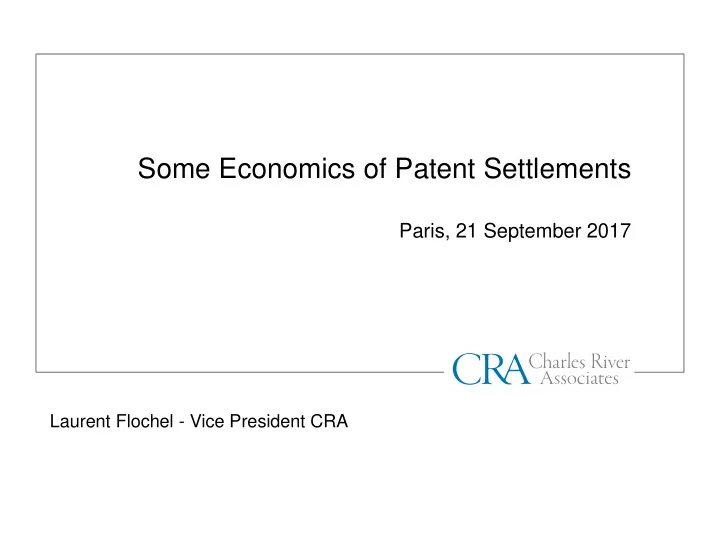

Some Economics of Patent Settlements Paris, 21 September 2017 Laurent Flochel - Vice President CRA
Two concerns about patent settlements Concerns about settlements that prevent weak patents from being “weeded 1. out” by the courts ➢ The extreme case of sham patents 2. Concerns about settlements in which consumer welfare is less than the expected consumer welfare if the parties had litigated ➢ Incentive to delay entry until patent expiration 2
Preliminary remarks – the « IP bargain » ➢ Patent : • Reward for an innovation and R&D investment ➢ rent given to the innovator • Ex post dead weight loss for consumers ➢ IP bargain : trade-off between these two opposite effects (dynamic efficiencies) 3
The game Bargaining Trial Innovator (A) wins Generic (B) wins p i : belief by i that he will win the litigation Settlement : • Value transfer • Other (compensation on other markets, early entry, …)
Is there a room for a deal? • Each party estimates his willingness to pay / willingness to accept (e.g. innovator (A) pays, generic (B) receives) WTA B WTP A Room for a deal Willingness to pay (to accept) depends on : • belief on the probability of winning the trial • litigation costs 5
The asymmetric risk Each party does not face the same risk in going to the trial ➢ Innovator : • Looses its profit on some markets • Side effects on other markets if reference pricing • Difficulty to be entirely compensated if wins the trial (limited responsibility, potentially huge damages – eg “at risk” entry ) • Enhanced if injunction is difficult to obtain • Litigation costs ➢ Generic : • Litigation costs Consequences: • A patent holder can have a rational incentive to pay significantly more than anticipated litigation expenses to settle patent litigation even when it believes there is a high probability that it will win at trial • A settlement payment that significantly exceeds litigation expenses cannot be treated as evidence of a sham patent 6
Value transfer settlements ➢ Value transfer facilitates the settlement – Amount is certain (any other compensation would incur a risk) – No reason that the value transfer would be limited to the amount of the (saved) litigation costs => Value transfer settlements should not be seen as negative per se 7
The articulation between antitrust and IPR • Should private incentives to settle be aligned with some social welfare objectives? ➢ No more than for a patent owner to set his price in order to maximize social welfare • Should Antitrust compensate for some potential failures of the IPR system? ➢ Why not addressing these potential failures with IP law/ rules? • Limitating the ability of patent owners to settle decreases their potential profit and therefore their reward for R&D investments and innovation ➢ Negative effect on innovation 8
What should we make of these basic facts? The “IP bargain” view : • The profits that the originator realizes prior to generic entry are the reward needed to encourage investment in R&D and innovation • The profits made possible by patent protection should not be equated with the supra-competitive profits made possible by a position of market dominance • Whether an originator possesses dominance prior to generic entry should be based on an assessment of the pre-generic competitive landscape The A102 view: • The fact that prices and originator profits drop so sharply following generic entry indicates that non-price competition was not sufficient to eliminate (antitrust) market power 9
Questions raised by the A102 view This approach means that nearly every patented product would be dominant prior to the end of patent protection (and not just in pharma). Is this a sensible approach to antitrust? Under this approach, the price observed following generic entry is regarded as the competitive price. What does this imply about how originators should price prior to generic entry? What does it imply about incentives to innovate? If non-price competition across molecules is regarded as ineffective at eliminating market power (such that molecules should be regarded as markets for A102 purposes), why does the Commission focus on markets defined at the ATC-3 level in many merger cases? 10
Recommend
More recommend